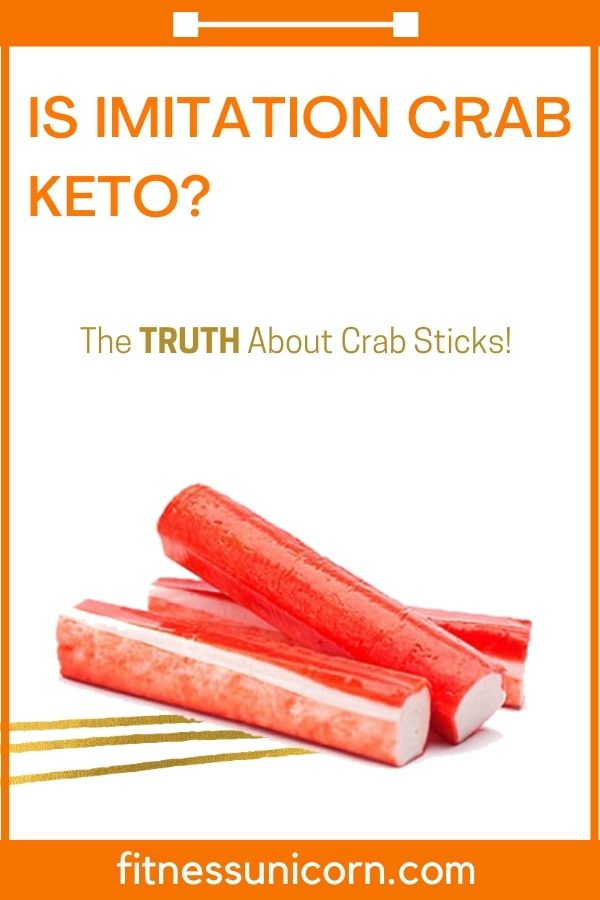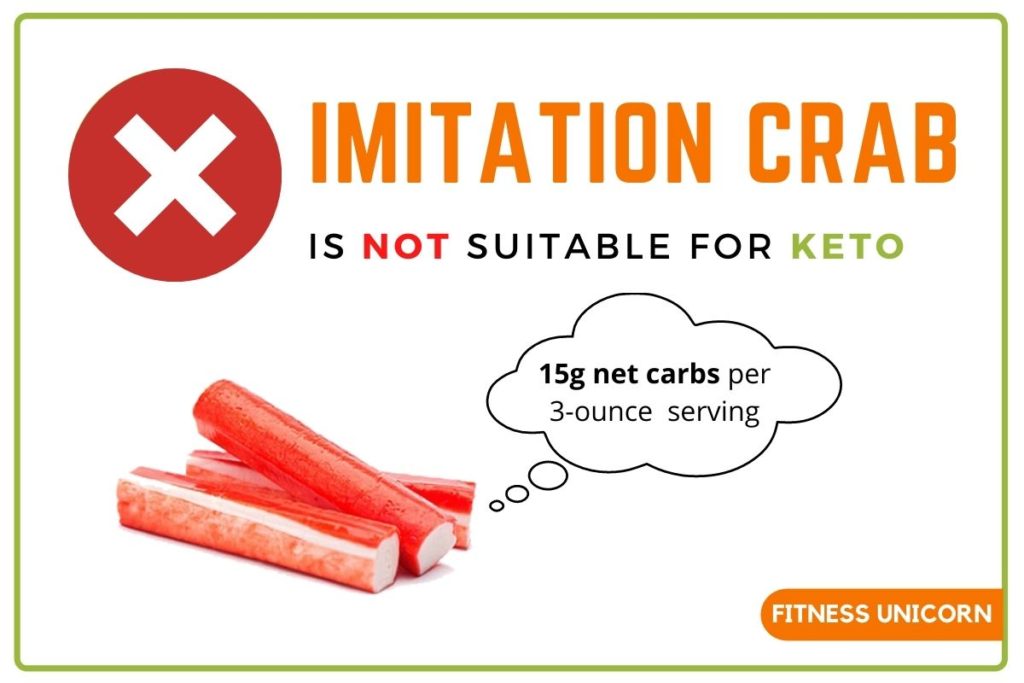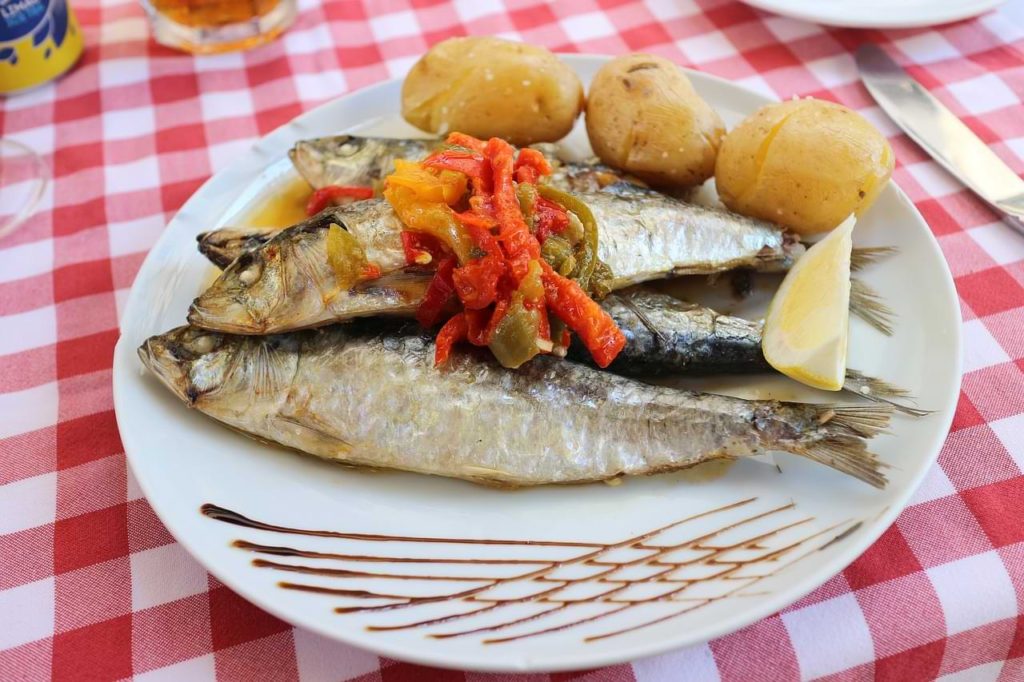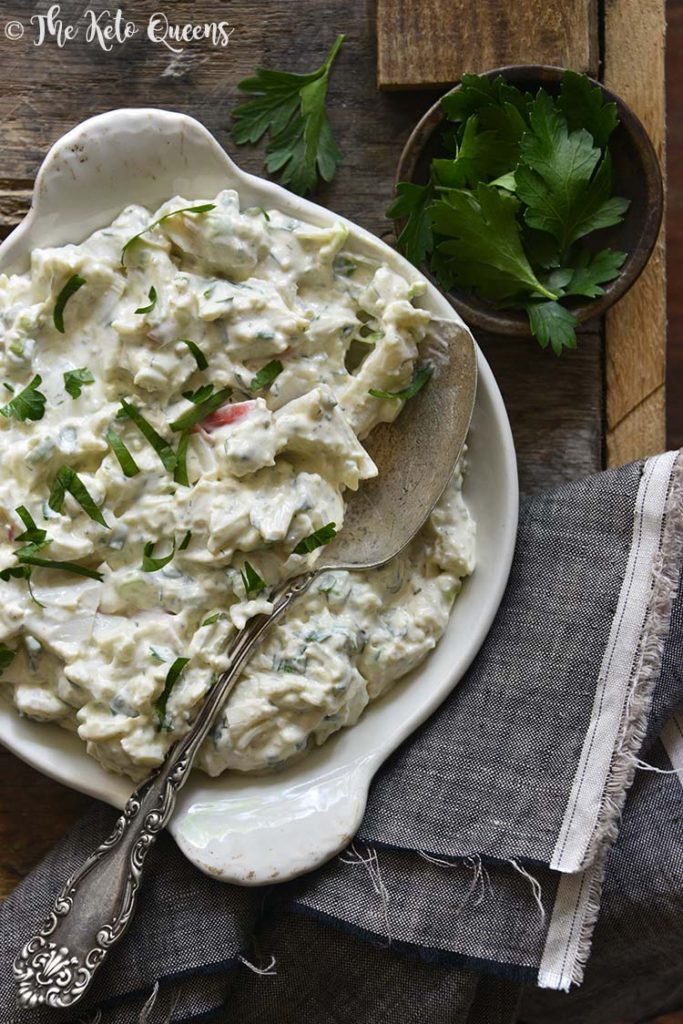If you’ve ever been to a sushi restaurant, there’s a high chance that you’ve eaten imitation crab knowingly or unknowingly! But, is imitation crab keto?
Imitation crab is a processed form of seafood which is also known as Crab sticks, Krab sticks, imitation crab meat, or seafood sticks. It is often found in famous food items like California rolls, crab rangoons, and crab cakes.

Thanks to its high shelf life and budget-friendliness, imitation crab or crab sticks are widely used in restaurants to cut down costs. It is also quite versatile and flexible in recipes.
Let’s find out how imitation crab fits on a keto diet, how it is made and what are the best alternatives.
Is Imitation Crab Keto
Imitation crab is not at all keto as it has more than 15g of net carbs in a three-ounce serving (85g). You are better off eating the real crab since most crabs (like shrimp) are free from carbohydrates.
There are more net carbs in imitation crab than the real crab! But what’s the reason?
Imitation crab or Krab is made with the minced flesh of fish skin. They then add starch (like wheat or tapioca) to thicken the texture along with some preservatives, flavoring agents, and sugar. It also contains egg whites that give it that smooth shiny look!
After all that processing, they further add MSG (some brands do) and vegetable oils to enhance their flavor and shelf life!
Since it is a processed food, there are more than a thousand types of imitation crab available in the market and restaurants.
You can surely check the carb count when buying the crabsticks from a grocery store, but what about the ones served in restaurants? There is no way you could find out what goes into making that imitation crab.
Just like hotdogs, imitation crab is made with cheaper qualities of raw material because the ultimate product comes out very fine and shiny!
Hence it’s better to stick to real crabs and adjust your daily carb requirements based on it. In fact, most crabs like shrimp are super keto-friendly and do not have any carbs.

What is Imitation Crab?
You may be thinking that if crabs are low carb, imitation crab must also be keto-friendly. However, things couldn’t be further from the truth!
Imitation crab meat is made with a gel-like substance called Kani surimi (made by grinding fish flesh). Manufacturers further add starch, flavoring agents, food colors to imitate the taste and texture of real crabs.
Contrary to popular belief, there is no part of crab in an imitation crab!
You might have seen imitation crab spelled as “krab” in restaurant menus to indicate that it’s not the “real” thing. Crab sticks come under the bigger umbrella of surumi-based products which are together called kamaboko in Japan.
Pallock is the most common fish used in manufacturing imitation crab meat due to its mass availability and cheap prices. Some premium brands also use healthier sources like cod, mackerel and barracuda.
Health impact of imitation crab is often compared with hotdogs, since they fall under the category of highly processed foods devoid of much nutrition!
How is Imitation Crab Made
These are the most common ingredients that goes into making the imitation crab around the world:
- Water: It is added to tweak the texture and increase quantity in order to control costs.
- Starch: Starch is added in the surimi pastes to thicken it. Most of the starch comes from potato, wheat, corn or tapioca.
- Protein: Egg-white is the dominant protein used in making imitation crab, as it adds a nice glossy finish to the product.
- Sugar and sorbitol: Sugar is used to enhance shelf life and also add to the taste.
- Vegetable oil: This is another unhealthy ingredient which is widely used in surumi based products. A healthy diet consists of cold pressed and natural oils like Sesame oil.
- Salt: Salt helps in binding the substance together and also enhances flavor.
These kinds of highly-processed foods are often looked down upon because we really don’t know what goes into the preparation. All we see is the end product which is smooth and shiny!
Fun Fact: It’s estimated that about 2%-3% of the world fisheries supply are used in manufacturing surimi-based food items, including imitation crab meat.
Is Imitation Crab Healthy?
Restaurants and snacks manufacturers love imitation crab as it is much cheaper than the real crab! But me and I should be more worried about their health aspects since we are the ones consuming it.
Imitation Crab vs Real Crab
Imitation crab is relatively lower in calories than fresh crab but contains more starch and added sugar, resulting into higher carbs.

Imitation crab seriously lacks in several micronutrients like Vitamin B12, Zinc, Selenium, and Copper. It also has much lesser protein than the fresh crabs.
Freshly cooked crabs are also a great source of thiamine, vitamin A, pantothenic acid, calcium, and potassium.
Potential Upsides of Imitation Crab on Keto
One of the major benefit of imitation crab is that its price is 1/3rd of the fresh crabs in market.
Crab sticks are also a very convenient and versatile food item that can easily blend into different recipes. There are also many ready-to-eat imitation crab snacks available in the market.
If you’re really concerned for your health and willing to put in some effort, you can find healthier versions of imitation crab (which usually come at a premium price).
Here is how the healthier versions of imitation crab look like:
- They have much more natural and organic ingredients like pea starch, cane sugar, sea salt, oat fiber, and natural flavoring agents.
- You may also find gluten-free variants without any GMO (Genetically modified) ingredients.
- Or they might me made from seafood that is sustainably sourced.
Even after getting the healthier versions of fake crab, you still can’t eat much of it on a keto diet due to the high carb content!
SUGGESTED: Joe’s Crab Shack Low-Carb Options
Negative Health Impact
Imitation crab is packed with harmful additives that can cause bodily issues like leaky gut and inflammation.
Since fake crab contains gluten, people with allergies might unknowingly consume it and end up with diarrhea, bloating, or fatigue.
And then there are added health risks from vegetable oils and artificial additives that are put in to increase the shelf life of the product.
Some brands also use MSG as a flavor enhancer in fake crab meat. MSG is often found in the majority of Asian dishes as it adds a very strong flavor to the dish.
If you are sensitive to MSG, you may experience unpleasant symptoms like headaches, muscle soreness, weakness, and numbness/tingling after consumption. That’s the main reason why MSG gets a bad rep in the health community!
Keto-ers generally look for food options with lots of fiber. Fiber lowers the GI of a food and makes it much more keto-friendly. On the other hand, Imitation crab is devoid of fiber and might cause blood sugar spikes.
Hence we conclude that you are better off avoiding this highly processed food.
Seafood Guide for Keto
It’s time to replace the fake crab meat with healthier options in your keto diet.
You’ll be amazed to know that there are plenty of seafood options on the keto diet!
Seafood is a great source of protein along with other micro and macronutrients! It’s also rich in Omega-3 fatty acids that support your heart and brain health.
Here are some of the most keto-friendly seafood picks:
Salmon
One serving (100g) of Salmon of Atlantic salmon packs 13 g fats, 20 g protein, and 0 net carbs! It is one of the most nutritious foods on the planet!
Salmon is a great source of long-chain omega-3 fatty acids, that work actively to reduce inflammation, lower blood pressure and decrease risk factors for disease.
It is also a common food among gym enthusiasts as it has more than 22 g of protein per 3.5 ounces serving! Salmon is an excellent source of various B vitamins that support heart and brain health.
Frequently eating salmon on keto can greatly reduce the number of tryglicerides and lower omega-6 fats. Most of us have a very high level of omega-6 fats coming from various junk foods. This can balance the levels of both fats and keep us healthy.
Salmon is also the most flexible seafood as it can be cooked in various forms like grilling, broiling, baking, etc.
Cod
Cod is a mildly flavored fish with white flesh. It’s loaded with proteins, vitamins and minerals and it’s super low in carb as well!
Cod is an excellent source of vitamin B12, niacin, phosphorus. A 4-ounce serving of cod contains 93 calories, 20 g protein, 1 g fat, and less than 1 g of net carbs.
Cod can be cooked in various ways including baking, grilling, broiling, and pan-frying.
I highly recommend you cook cod in moist heats as it may dry out and become stiff otherwise.
Here’s how to check if your Cod has been cooked properly: The flesh should turn opaque. Now pick a fork and slightly scrape the flesh. A well cooked cod should turn flaky when scraped.
On a keto diet, you can use various seasonings like extra virgin olive oil, lemon juice, pepper, salt, etc.
Sardines
Sardines are small fishes that are packed with nutrients and are super low in carbs.
They are an excellent source of vitamins, minerals, proteins and highly beneficial omega-3 fatty acids.

Since they are highly perishable, you have to make sure you buy the fresh ones.
This is how you can check whether you purchased the right Sardines:
- They should smell fresh
- It should have a glossy outer skin
- Look for bright eyes
- Texture should be firm
Sardines can be had as a snack or used in salads. They are highly versatile because of their mild taste.
Mackerel
Mackerel is an oily fish that is an excellent source of healthy fats.
Its fat profile is comparable with Salmon and is one of the best keto superfoods. One 80g fillet contains 20 g of good fats and 15 g with 0 net carbs!
Mackerel is quite inexpensive. Spanish Mackerel and King Mackerel are quite high in mercury and hence you should stick to Atlantic Mackerel.
Tuna
Tuna is the easiest seafood to cook as you just have to sear it in high heat.
A fresh tuna fish is the one that looks shiny and smells fresh! You should avoid yellowfin, albacore, and ahi tuna as they have higher mercury levels.
Canned tuna is inexpensive and highly loaded with protein. It has a great shelf life going up to 5 years!
In addition to healthy Omega-3 fats, canned tuna is an excellent source of vitamins and minerals, especially vitamin D and selenium.
Larger varieties of tuna are often linked to high mercury content. Stick with the smaller varieties like light tuna or skipjack.
Shrimp
Shrimp is the most common type of shellfish that is also quite rich in iodine. Iodine is a major requirement for a well functioning thyroid system and good brain health.
A 3-ounce (85g) serving of Shrimp contains 83 calories, 18 g protein, 0 fat and 0 carbs, which makes it quite a keto-friendly seafood.
Shrimp could make a great addition to salads and you can also use it in place of imitation crab on the keto diet!
Its high protein content makes it the best and easiest way to fulfill your protein requirements on keto.
Low Carb Keto Crab Salad Recipe
This Keto recipe from The Keto Queens is my all-time favorite crab salad recipe!
It has a creamy texture with the right blend of spices! It’s unique flavor comes from sautéed onion and garlic, Old Bay spice mix, Worcestershire sauce, lemon juice, and other herbs.
Given the unhealthy and high carb aspects of imitation crab, this recipe uses lump crab instead! Lump crab is the meat that comes from the main body of a crab instead of legs or claws.

Get the complete recipe from The Keto Queens
Conclusion
Is imitation crab keto?
Imitation crab is not keto in any way as it has more than 15 g of net carbs per serving of 3 ounces. You should stick to the real crab and other keto-friendly seafood such as Salmon, Mahi Mahi, or Sardines, or Cod.
Imitation crab is made of ground fish-flesh which is further processed into a smooth product. It is highly artificial and devoid of nutrition.
Manufacturers of imitation crab add in unhealthy ingredients like sugar, starch, MSG, and vegetable oils to reach the desired look and texture. This ends up inflating the carb content, so much so that it has the same amount of carbs as that of white bread!
